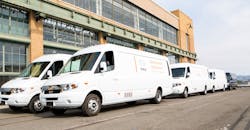The fleet industry is ever-changing to keep up with shifts in technology and to identify ways to increase efficiencies and save on cost. Environmental impact plays an important role in where the fleet industry is heading. While electric vehicles are becoming more of an interest for green solutions, electrification is not always the best fit for a fleet.
There is plenty to consider before switching to an electric fleet and understanding the benefits and challenges is vital to get the most out of your vehicles. Many factors play a role in whether electrification is right for your fleet such as where you are located, typical driving distance and start-and-go frequency.
Identifying your needs
There are pros and cons to having an electric fleet. For some, it might make a big difference in cost and environmental impact, but to others it may not provide the return on investment necessary to justify the change. Before making the switch to electric, be sure to consider the following:
- Size: At present, electrification is most effective for small vehicles and small fleets. It’s an understatement to say it takes a large amount of energy to charge a fleet of electric engines. To charge a single line haul truck with 500 miles of range would require the batteries of 90,000 cell phones. You will need to have the space and electric capacity to charge the vehicles efficiently. Additionally, when it comes to energy consumption, a physically smaller vehicle is more ideal for electrification. Lighter vehicles use less energy when driving and when charging, so power requirements are less than large, long-haul trucks.
- Location: Electric vehicles are sensitive to climate and perform best in areas that have consistently mild conditions. Extreme temperatures can lead to problems like battery issues. Electric fleets are more common in urban areas, such as LA, that are eager to keep emissions low. Some states and cities provide tax breaks on electric vehicles, which can also help you determine if going electric makes sense for your business. However, be sure to know the full scope of those tax breaks as some are only temporary.
- Purpose: How you are using your fleet can also affect whether going electric will be a beneficial move or not. Electric vehicles are most successful with vocational fleets, which are stopping frequently and traveling only short distances daily. Stop-and-go vehicles, such as parcel delivery trucks, are ideal for electrification, as electric engines repurpose the energy generated from braking to fuel accelerations, maintaining battery levels longer. Additionally, all work is accomplished during the business day, leaving the evening hours for consistent charging during times of low energy-use. Long-haul vehicles that travel at a steady speed for long periods of time can drain the battery quickly, and being able to access a consistent point of recharge can be a challenge. Therefore, using an electric vehicle with current technology would be less efficient than a traditional diesel engine.
Navigating New Territory
Compressed Natural Gas (CNG) was a new idea that the refuse hauling industry took and ran with. Even with that kind of “all-in” mentality, it still has taken over a decade to achieve widespread adoption of CNG. Electrification is still a relatively new technology, and the fleet industry is not quite prepared to go there yet – so you can imagine it will take some time before we’re seeing large fleets switch over. After all, it’s much easier to start from scratch with electrification than it is to retro-fit existing fleets with this technology.
As the industry changes, Horton, Inc. is eager to find new ways to support our customers. Electric engines are changing the game, but with new technology, there is always a learning curve. Fortunately, the rate of change is gradual, which is giving us the opportunity to listen to our customers and develop solutions to improve their experience – whether in an electric or a traditional vehicle.
The technology for these vehicles is being tested and improved every day in order to get the most out of using electric vehicles. There is still much room to grow from vehicle design to efficient charging, and by remaining engaged and being a part of the conversation, Horton, Inc. continues to test new ways to provide solutions to customers – even when using electric vehicles. The best ideas are still out there, and we’re interested in keeping the conversation going.
To learn more about Horton’s latest technologies, please visit hortonww.com or email [email protected].
